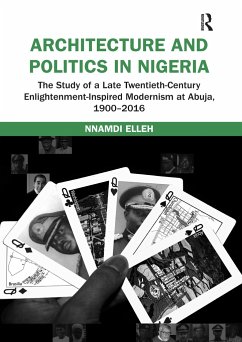Nnamdi Elleh (Professor of Architecture, University of Cincinnati,
Architecture and Politics in Nigeria
The Study of a Late Twentieth-Century Enlightenment-Inspired Modernism at Abuja, 1900-2016
Nnamdi Elleh (Professor of Architecture, University of Cincinnati,
Architecture and Politics in Nigeria
The Study of a Late Twentieth-Century Enlightenment-Inspired Modernism at Abuja, 1900-2016
- Broschiertes Buch
- Merkliste
- Auf die Merkliste
- Bewerten Bewerten
- Teilen
- Produkt teilen
- Produkterinnerung
- Produkterinnerung
By examining the creation of the modernist national public spaces of Abuja within a broader historical and global context, this book looks at how the successes and the failures of these spaces have affected the citizens of the country.
Andere Kunden interessierten sich auch für
![The Routledge Companion to Twentieth and Early Twenty-First Century Urban Design The Routledge Companion to Twentieth and Early Twenty-First Century Urban Design]() Jon LangThe Routledge Companion to Twentieth and Early Twenty-First Century Urban Design260,99 €
Jon LangThe Routledge Companion to Twentieth and Early Twenty-First Century Urban Design260,99 €![Architecture of Defeat Architecture of Defeat]() Kengo Kuma (Kengo Kuma Architects and Japan Associates)Architecture of Defeat55,99 €
Kengo Kuma (Kengo Kuma Architects and Japan Associates)Architecture of Defeat55,99 €![Politics in Developing Countries Politics in Developing Countries]() Damien KingsburyPolitics in Developing Countries179,99 €
Damien KingsburyPolitics in Developing Countries179,99 €![Appraising the Nigerian Problem Through Education and Religious Dialogue Appraising the Nigerian Problem Through Education and Religious Dialogue]() Rowland OnyenaliAppraising the Nigerian Problem Through Education and Religious Dialogue54,90 €
Rowland OnyenaliAppraising the Nigerian Problem Through Education and Religious Dialogue54,90 €![Designing Therapeutic Environments Designing Therapeutic Environments]() Designing Therapeutic Environments58,99 €
Designing Therapeutic Environments58,99 €![African Identities and International Politics African Identities and International Politics]() Frank Aragbonfoh AbumereAfrican Identities and International Politics177,99 €
Frank Aragbonfoh AbumereAfrican Identities and International Politics177,99 €![The Politics of Elite Corruption in Africa The Politics of Elite Corruption in Africa]() Roger TangriThe Politics of Elite Corruption in Africa51,99 €
Roger TangriThe Politics of Elite Corruption in Africa51,99 €-
-
-
By examining the creation of the modernist national public spaces of Abuja within a broader historical and global context, this book looks at how the successes and the failures of these spaces have affected the citizens of the country.
Produktdetails
- Produktdetails
- Verlag: Taylor & Francis Ltd
- Seitenzahl: 300
- Erscheinungstermin: 30. September 2020
- Englisch
- Abmessung: 173mm x 243mm x 30mm
- Gewicht: 626g
- ISBN-13: 9780367667955
- ISBN-10: 0367667959
- Artikelnr.: 59989376
- Herstellerkennzeichnung
- Libri GmbH
- Europaallee 1
- 36244 Bad Hersfeld
- gpsr@libri.de
- Verlag: Taylor & Francis Ltd
- Seitenzahl: 300
- Erscheinungstermin: 30. September 2020
- Englisch
- Abmessung: 173mm x 243mm x 30mm
- Gewicht: 626g
- ISBN-13: 9780367667955
- ISBN-10: 0367667959
- Artikelnr.: 59989376
- Herstellerkennzeichnung
- Libri GmbH
- Europaallee 1
- 36244 Bad Hersfeld
- gpsr@libri.de
Nnamdi Elleh, Ph.D., is Professor of Architecture at the University of Cincinnati, Ohio. His research interests include modern and contemporary architecture understood as diverse, multi-centered, regional, vernacular and localized experiences in different parts of the world.
Preface Prologue Method, Sources and the Organization of the Book 1. The
Literature 1.1. Abuja in Nigerian and African Modern Architectural History
1.2. Locating Abuja's Urban Form in Global Architectural Modernism 1.3.
Abuja as a Post-Colonial Capital City after World War II 1.4. Abuja: A
Capital City in Dis-Content with Architectural Modernism(s) 1.5. Public
Space in the Aftermath of the Iranian Revolution and in the Post-Berlin
Wall Contexts 2. The Inauguration 2.1. The Inauguration in the Civic Space,
2 December 1991 2.2. Contestations and Wars in the Public Spaces of Abuja
2.3. Emancipation in the Public Spaces at Abuja and in Nigerian Cities 2.4.
Abuja As The Public Sphere for Transforming Nigeria 3. The Amalgamation of
Nigeria and the Search for Capital City Location, 1900 - 1960 3.1 Nigeria:
A Union of Traditional and Colonial World-Views 3.2 Modern Landscapes
World-Views of Nigeria Capitalist Project 3.3 Colonial Debates to Establish
Nigeria and its National Seat of Government 3.4 Lugard and the Dual Mandate
World-View Plan for Nigeria 3.5. The Social Space Facilitated by Lugard
when he Established Nigeria, 1900 - 1960 3.6 Insiders' Perspective I:
Senator Abu Ibrahim and Professor Akin Mabogunje 4. Abuja: A National
Development Project or A Military Conspiracy Against Lagos? 4.1 General
Obasanjo: Making the Development of FCT Irreversible, 1976 - 1979 4.2 The
Competition and the Selection of Thomas Todd and Kenzo Tange 4.3. President
Shehu Shagari: The Light That Failed During The Rush to Build Abuja, 1979
to 1983 4.4 Insider's Perspectives II: Umar G. Benna 4.5 Insider's
Perspective III: E. A. D. Nsiegbe 4.6 Insider's Perspective IV: Denis
Browne 5. The Paths to One of the Most Enormous Commercial Disputes in
History
Literature 1.1. Abuja in Nigerian and African Modern Architectural History
1.2. Locating Abuja's Urban Form in Global Architectural Modernism 1.3.
Abuja as a Post-Colonial Capital City after World War II 1.4. Abuja: A
Capital City in Dis-Content with Architectural Modernism(s) 1.5. Public
Space in the Aftermath of the Iranian Revolution and in the Post-Berlin
Wall Contexts 2. The Inauguration 2.1. The Inauguration in the Civic Space,
2 December 1991 2.2. Contestations and Wars in the Public Spaces of Abuja
2.3. Emancipation in the Public Spaces at Abuja and in Nigerian Cities 2.4.
Abuja As The Public Sphere for Transforming Nigeria 3. The Amalgamation of
Nigeria and the Search for Capital City Location, 1900 - 1960 3.1 Nigeria:
A Union of Traditional and Colonial World-Views 3.2 Modern Landscapes
World-Views of Nigeria Capitalist Project 3.3 Colonial Debates to Establish
Nigeria and its National Seat of Government 3.4 Lugard and the Dual Mandate
World-View Plan for Nigeria 3.5. The Social Space Facilitated by Lugard
when he Established Nigeria, 1900 - 1960 3.6 Insiders' Perspective I:
Senator Abu Ibrahim and Professor Akin Mabogunje 4. Abuja: A National
Development Project or A Military Conspiracy Against Lagos? 4.1 General
Obasanjo: Making the Development of FCT Irreversible, 1976 - 1979 4.2 The
Competition and the Selection of Thomas Todd and Kenzo Tange 4.3. President
Shehu Shagari: The Light That Failed During The Rush to Build Abuja, 1979
to 1983 4.4 Insider's Perspectives II: Umar G. Benna 4.5 Insider's
Perspective III: E. A. D. Nsiegbe 4.6 Insider's Perspective IV: Denis
Browne 5. The Paths to One of the Most Enormous Commercial Disputes in
History
Preface Prologue Method, Sources and the Organization of the Book 1. The
Literature 1.1. Abuja in Nigerian and African Modern Architectural History
1.2. Locating Abuja's Urban Form in Global Architectural Modernism 1.3.
Abuja as a Post-Colonial Capital City after World War II 1.4. Abuja: A
Capital City in Dis-Content with Architectural Modernism(s) 1.5. Public
Space in the Aftermath of the Iranian Revolution and in the Post-Berlin
Wall Contexts 2. The Inauguration 2.1. The Inauguration in the Civic Space,
2 December 1991 2.2. Contestations and Wars in the Public Spaces of Abuja
2.3. Emancipation in the Public Spaces at Abuja and in Nigerian Cities 2.4.
Abuja As The Public Sphere for Transforming Nigeria 3. The Amalgamation of
Nigeria and the Search for Capital City Location, 1900 - 1960 3.1 Nigeria:
A Union of Traditional and Colonial World-Views 3.2 Modern Landscapes
World-Views of Nigeria Capitalist Project 3.3 Colonial Debates to Establish
Nigeria and its National Seat of Government 3.4 Lugard and the Dual Mandate
World-View Plan for Nigeria 3.5. The Social Space Facilitated by Lugard
when he Established Nigeria, 1900 - 1960 3.6 Insiders' Perspective I:
Senator Abu Ibrahim and Professor Akin Mabogunje 4. Abuja: A National
Development Project or A Military Conspiracy Against Lagos? 4.1 General
Obasanjo: Making the Development of FCT Irreversible, 1976 - 1979 4.2 The
Competition and the Selection of Thomas Todd and Kenzo Tange 4.3. President
Shehu Shagari: The Light That Failed During The Rush to Build Abuja, 1979
to 1983 4.4 Insider's Perspectives II: Umar G. Benna 4.5 Insider's
Perspective III: E. A. D. Nsiegbe 4.6 Insider's Perspective IV: Denis
Browne 5. The Paths to One of the Most Enormous Commercial Disputes in
History
Literature 1.1. Abuja in Nigerian and African Modern Architectural History
1.2. Locating Abuja's Urban Form in Global Architectural Modernism 1.3.
Abuja as a Post-Colonial Capital City after World War II 1.4. Abuja: A
Capital City in Dis-Content with Architectural Modernism(s) 1.5. Public
Space in the Aftermath of the Iranian Revolution and in the Post-Berlin
Wall Contexts 2. The Inauguration 2.1. The Inauguration in the Civic Space,
2 December 1991 2.2. Contestations and Wars in the Public Spaces of Abuja
2.3. Emancipation in the Public Spaces at Abuja and in Nigerian Cities 2.4.
Abuja As The Public Sphere for Transforming Nigeria 3. The Amalgamation of
Nigeria and the Search for Capital City Location, 1900 - 1960 3.1 Nigeria:
A Union of Traditional and Colonial World-Views 3.2 Modern Landscapes
World-Views of Nigeria Capitalist Project 3.3 Colonial Debates to Establish
Nigeria and its National Seat of Government 3.4 Lugard and the Dual Mandate
World-View Plan for Nigeria 3.5. The Social Space Facilitated by Lugard
when he Established Nigeria, 1900 - 1960 3.6 Insiders' Perspective I:
Senator Abu Ibrahim and Professor Akin Mabogunje 4. Abuja: A National
Development Project or A Military Conspiracy Against Lagos? 4.1 General
Obasanjo: Making the Development of FCT Irreversible, 1976 - 1979 4.2 The
Competition and the Selection of Thomas Todd and Kenzo Tange 4.3. President
Shehu Shagari: The Light That Failed During The Rush to Build Abuja, 1979
to 1983 4.4 Insider's Perspectives II: Umar G. Benna 4.5 Insider's
Perspective III: E. A. D. Nsiegbe 4.6 Insider's Perspective IV: Denis
Browne 5. The Paths to One of the Most Enormous Commercial Disputes in
History








